Johann Sebastian Bach
From Wikipedia, the free encyclopedia
This article is about the Baroque composer. For his grandson of the same name, see Johann Sebastian Bach (painter). For other uses of Bach, see Bach (disambiguation).
| Johann Sebastian Bach | |
|---|---|

Portrait of Bach, aged 61, by E. G. Haussmann, 1748
| |
| Born | 21 March 1685 (O.S.) 31 March 1685 (N.S.) Eisenach |
| Died | 28 July 1750 (aged 65) Leipzig |
| Works | List of compositions |
| Signature | |
 | |
Bach's abilities as an organist were highly respected during his lifetime, although he was not widely recognised as a great composer until a revival of interest in and performances of his music in the first half of the 19th century. He is now generally regarded as one of the greatest composers of all time.[4]
Contents
[hide]- 1 Life
- 2 Musical style
- 3 Compositions
- 4 Reception
- 5 Notes
- 6 References
- 7 Bibliography
- 8 External links
Life
Bach was born in Eisenach, in the duchy of Saxe-Eisenach, into a great musical family. His father Johann Ambrosius Bach was the director of the town musicians, and all of his uncles were professional musicians. His father probably taught him to play the violin and harpsichord, and his brother Johann Christoph Bach taught him the clavichord and exposed him to much contemporary music.[5] Apparently at his own initiative, Bach attended St. Michael's School in Lüneburg for two years. After graduating he held several musical posts across Germany: he served as Kapellmeister (director of music) to Leopold, Prince of Anhalt-Köthen, and as Thomaskantor in Leipzig, a position of music director at the main Lutheran churches and educator at the Thomasschule. He received the title of "Royal Court Composer" from Augustus III in 1736.[6][7] Bach's health and vision declined in 1749, and he died on 28 July 1750.Childhood (1685–1703)

St. George's Church in Eisenach, where Bach was baptised. Portal inscription: "Ein feste Burg ist unser Gott"

The Wender organ Bach played in Arnstadt
See also: Bach family
Johann Sebastian Bach was born in Eisenach, the capital of the duchy of Saxe-Eisenach, in present-day Germany, on 21 March 1685 O.S. (31 March 1685 N.S.). He was the son of Johann Ambrosius Bach, the director of the town musicians, and Maria Elisabeth Lämmerhirt.[8] He was the eighth and youngest child of Johann Ambrosius,[9] who probably taught him violin and the basics of music theory.[10] His uncles were all professional musicians, whose posts included church organists, court chamber musicians, and composers. One uncle, Johann Christoph Bach (1645–93), introduced him to the organ, and an older second cousin, Johann Ludwig Bach (1677–1731), was a well-known composer and violinist.[11]Bach's mother died in 1694, and his father died eight months later.[7] The 10-year-old Bach moved in with his eldest brother, Johann Christoph Bach (1671–1721), the organist at St. Michael's Church in Ohrdruf, Saxe-Gotha-Altenburg.[12] There he studied, performed, and copied music, including his own brother's, despite being forbidden to do so because scores were so valuable and private and blank ledger paper of that type was costly.[13][14] He received valuable teaching from his brother, who instructed him on the clavichord. J.C. Bach exposed him to the works of great composers of the day, including South German composers such as Johann Pachelbel (under whom Johann Christoph had studied) and Johann Jakob Froberger; North German composers;[5] Frenchmen, such as Jean-Baptiste Lully, Louis Marchand, and Marin Marais; and the Italian clavierist Girolamo Frescobaldi. Also during this time he was taught theology, Latin, Greek, French and Italian at the local gymnasium.[15]
By 3 April 1700 Bach and his schoolfriend Georg Erdmann–who was two years Bach's elder–were enrolled in the prestigious St. Michael's School in Lüneburg, some two weeks' travel north of Ohrdruf.[16][17] Their journey was probably undertaken mostly on foot.[15][17] His two years there were critical in exposing Bach to a wider range of European culture. In addition to singing in the choir, he played the School's three-manual organ and harpsichords.[15] He came into contact with sons of aristocrats from northern Germany, sent to the highly selective school to prepare for careers in other disciplines.
While in Lüneburg, Bach had access to St. John's Church and possibly used the church's famous organ from 1553, since it was played by his organ teacher Georg Böhm.[18] Because of his musical talent Bach had significant contact with Böhm while a student in Lüneburg, and also took trips to nearby Hamburg where he observed "the great North German organist Johann Adam Reincken".[18][19] Stauffer reports the discovery in 2005 of the organ tablatures that Bach wrote out when still in his teens of works by Reincken and Dieterich Buxtehude, showing "a disciplined, methodical, well-trained teenager deeply committed to learning his craft".[18]
Weimar, Arnstadt, and Mühlhausen (1703–08)

Portrait of the young Bach (disputed).[20]
Despite strong family connections and a musically enthusiastic employer, tension built up between Bach and the authorities after several years in the post. Bach was dissatisfied with the standard of singers in the choir, while his employer was upset by his unauthorised absence from Arnstadt; Bach was gone for several months in 1705–06, to visit the great organist and composer Dieterich Buxtehude and his Abendmusiken at St. Mary's Church in the northern city of Lübeck. The visit to Buxtehude involved a 450-kilometre (280 mi) journey each way, reportedly on foot.[24]
In 1706, Bach applied for a post as organist at the Blasius Church (also known as St Blasius or as Divi Blasii) in Mühlhausen.[25][26] As part of his application he had a cantata performed on Easter, 24 April 1707, likely an early version of his Christ lag in Todes Banden.[27] A month later Bach's application was accepted and he took up the post in July.[25] The position included a significantly higher remuneration, improved conditions, and a better choir. Four months after arriving at Mühlhausen, Bach married Maria Barbara Bach, his second cousin. Bach was able to convince the church and town government at Mühlhausen to fund an expensive renovation of the organ at the Blasius Church. In 1708 Bach wrote Gott ist mein König, a festive cantata for the inauguration of the new Council, which was published at the Council's expense.[15]
Return to Weimar (1708–17)

Bach's autograph of the first movement of the Sonata No. 1 in G minor for solo violin (BWV 1001) –  Audio.
Audio.
For more details on this topic, see Erschallet, ihr Lieder, erklinget, ihr Saiten! BWV 172 § Background.
In 1708, Bach left Mühlhausen, returning to Weimar this time as organist and from 1714 Konzertmeister (director of music) at the ducal court, where he had an opportunity to work with a large, well-funded contingent of professional musicians.[15] Bach and his wife moved into a house close to the ducal palace.[28] Later the same year, their first child, Catharina Dorothea, was born, and Maria Barbara's elder, unmarried sister joined them. She remained to help run the household until her death in 1729. Three sons were also born in Weimar: Wilhelm Friedemann, Carl Philipp Emanuel and Johann Gottfried Bernhard. Johann Sebastian and Maria Barbara had three more children who however did not live to their first birthday, including twins born in 1713.[29]Bach's time in Weimar was the start of a sustained period of composing keyboard and orchestral works. He attained the proficiency and confidence to extend the prevailing structures and to include influences from abroad. He learned to write dramatic openings and employ the dynamic motor rhythms and harmonic schemes found in the music of Italians such as Vivaldi, Corelli, and Torelli. Bach absorbed these stylistic aspects in part by transcribing Vivaldi's string and wind concertos for harpsichord and organ; many of these transcribed works are still regularly performed. Bach was particularly attracted to the Italian style in which one or more solo instruments alternate section-by-section with the full orchestra throughout a movement.[30]
In Weimar, Bach continued to play and compose for the organ, and to perform concert music with the duke's ensemble.[15] He also began to write the preludes and fugues which were later assembled into his monumental work The Well-Tempered Clavier (Das Wohltemperierte Klavier—"Klavier" meaning clavichord or harpsichord),[31] consisting of two books, compiled in 1722 and 1744,[32] each containing 24 preludes and fugues in every major and minor key.
Also in Weimar Bach started work on the Little Organ Book, containing traditional Lutheran chorales (hymn tunes) set in complex textures. In 1713, Bach was offered a post in Halle when he advised the authorities during a renovation by Christoph Cuntzius of the main organ in the west gallery of the Market Church of Our Dear Lady. Johann Kuhnau and Bach played again when it was inaugurated in 1716.[33][34]
In the spring of 1714, Bach was promoted to Konzertmeister, an honour that entailed performing a church cantata monthly in the castle church.[35] The first three cantatas Bach composed in Weimar were Himmelskönig, sei willkommen, BWV 182, for Palm Sunday, which coincided with the Annunciation that year, Weinen, Klagen, Sorgen, Zagen, BWV 12, for Jubilate Sunday, and Erschallet, ihr Lieder, erklinget, ihr Saiten! BWV 172 for Pentecost.[36] Bach's first Christmas cantata Christen, ätzet diesen Tag, BWV 63 was premiered in 1714 or 1715.[37][38]
In 1717, Bach eventually fell out of favour in Weimar and was, according to a translation of the court secretary's report, jailed for almost a month before being unfavourably dismissed: "On November 6, [1717], the quondam concertmaster and organist Bach was confined to the County Judge's place of detention for too stubbornly forcing the issue of his dismissal and finally on December 2 was freed from arrest with notice of his unfavourable discharge."[39]
Köthen (1717–23)
Despite being born in the same year and only about 130 kilometres (81 mi) apart, Bach and Handel never met. In 1719, Bach made the 35-kilometre (22 mi) journey from Köthen to Halle with the intention of meeting Handel, however Handel had left the town.[42] In 1730, Bach's oldest son Wilhelm Friedemann travelled to Halle to invite Handel to visit the Bach family in Leipzig, but the visit did not come to pass.[43]
On 7 July 1720, while Bach was away in Carlsbad with Prince Leopold, Bach's wife suddenly died.[44] The following year, he met Anna Magdalena Wilcke, a young, highly gifted soprano sixteen years his junior, who performed at the court in Köthen; they married on 3 December 1721.[45] Together they had thirteen more children, six of whom survived into adulthood: Gottfried Heinrich; Elisabeth Juliane Friederica (1726–81), who married Bach's pupil Johann Christoph Altnickol; Johann Christoph Friedrich and Johann Christian, who both, especially Johann Christian, became significant musicians; Johanna Carolina (1737–81); and Regina Susanna (1742–1809).[46]
Leipzig (1723–50)
For more details on this topic, see Jesus nahm zu sich die Zwölfe, BWV 22 § Audition in Leipzig.
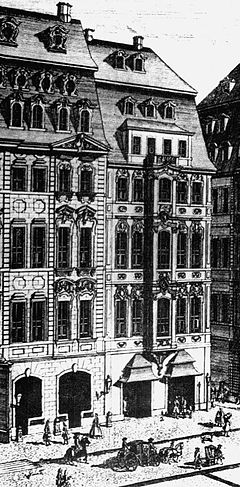
Café Zimmermann, Leipzig, where the Collegium Musicum performed

Bach's grave and altar in the St. Thomas Church, Leipzig
Bach was required to instruct the students of the Thomasschule in singing and to provide church music for the main churches in Leipzig. Bach was required to teach Latin, but he was allowed to employ four "prefects" (deputies) to do this instead. The prefects also aided with musical instruction.[52] A cantata was required for the church services on Sundays and additional church holidays during the liturgical year. Bach usually led performances of his cantatas, most of which were composed within three years of his relocation to Leipzig. The first was Die Elenden sollen essen, BWV 75, performed in the Nikolaikirche on 30 May 1723, the first Sunday after Trinity. Bach collected his cantatas in annual cycles. Five are mentioned in obituaries, three are extant.[36] Of the more than three hundred cantatas which Bach composed in Leipzig, over one hundred have been lost to posterity.[3] Most of these concerted works expound on the Gospel readings prescribed for every Sunday and feast day in the Lutheran year. Bach started a second annual cycle the first Sunday after Trinity of 1724, and composed only chorale cantatas, each based on a single church hymn. These include O Ewigkeit, du Donnerwort, BWV 20, Wachet auf, ruft uns die Stimme, BWV 140, Nun komm, der Heiden Heiland, BWV 62, and Wie schön leuchtet der Morgenstern, BWV 1.
Bach drew the soprano and alto choristers from the School, and the tenors and basses from the School and elsewhere in Leipzig. Performing at weddings and funerals provided extra income for these groups; it was probably for this purpose, and for in-school training, that he wrote at least six motets.[53] As part of his regular church work, he performed other composers' motets, which served as formal models for his own.[54]
Bach's predecessor as Cantor, Johann Kuhnau, had also been music director for the Paulinerkirche, the church of Leipzig University. But when Bach was installed as Cantor in 1723, he was put in charge only of music for "festal" (church holiday) services at the Paulinerkirche; his petition to provide music also for regular Sunday services there (for a corresponding salary increase) went all the way up to the Elector but was denied. After this, in 1725, Bach "lost interest" in working even for festal services at the Paulinerkirche and appeared there only on "special occasions".[55] The Paulinerkirche had a much better and newer (1716) organ than did the Thomaskirche or the Nikolaikirche. Bach had been consulted officially about the 1716 organ after its completion, came from Köthen, and submitted a report.[56] Bach was not required to play any organ in his official duties, but it is believed he liked to play on the Paulinerkirche organ "for his own pleasure".[57]
Bach broadened his composing and performing beyond the liturgy by taking over, in March 1729, the directorship of the Collegium Musicum, a secular performance ensemble started by Telemann. This was one of the dozens of private societies in the major German-speaking cities that was established by musically active university students; these societies had become increasingly important in public musical life and were typically led by the most prominent professionals in a city. In the words of Christoph Wolff, assuming the directorship was a shrewd move that "consolidated Bach's firm grip on Leipzig's principal musical institutions".[58] Year round, the Leipzig's Collegium Musicum performed regularly in venues such as the Café Zimmermann, a coffeehouse on Catherine Street off the main market square. Many of Bach's works during the 1730s and 1740s were written for and performed by the Collegium Musicum; among these were parts of his Clavier-Übung (Keyboard Practice) and many of his violin and keyboard concertos.[15]
In 1733, Bach composed a mass for the Dresden court (Kyrie and Gloria) which he later incorporated in his Mass in B Minor. He presented the manuscript to the Elector in an eventually successful bid to persuade the prince to give him the title of Court Composer.[6] He later extended this work into a full mass, by adding a Credo, Sanctus, and Agnus Dei, the music for which was partly based on his own cantatas, partly newly composed. Bach's appointment as Court Composer was part of his long-term struggle to achieve greater bargaining power with the Leipzig council. Between 1737 and 1739, Bach's former pupil Carl Gotthelf Gerlach held the directorship of the Collegium Musicum.
In 1747, Bach visited the court of King Frederick II of Prussia at Potsdam. The king played a theme for Bach and challenged him to improvise a fugue based on his theme. Bach improvised a three-part fugue on one of Frederick's fortepianos, then a novelty, and later presented the king with a Musical Offering consisting of fugues, canons, and a trio based on this theme. Its six-part fugue includes a slightly altered subject more suitable for extensive elaboration.
In the same year, Bach joined the Corresponding Society of the Musical Sciences (Correspondierende Societät der musikalischen Wissenschafften) of Lorenz Christoph Mizler. On the occasion of his entry into the Society, Bach composed the Canonic Variations on "Vom Himmel hoch da komm' ich her" (BWV 769).[59] A portrait had to be submitted by each member of the Society, so in 1746, during the preparation of Bach's entry, the famous Bach portrait was painted by Elias Gottlob Haussmann.[60] The Canon triplex á 6 Voc (BWV 1076) on this portrait was dedicated to the Society.[61] Other late works by Bach may also have a connection with the music theory based Society.[62] One of those works was The Art of Fugue, which consists of 18 complex fugues and canons based on a simple theme.[63] The Art of Fugue was only published posthumously in 1751.[64]
Bach's last large work was the Mass in B minor (1748–49) which Stauffer describes as "Bach's most universal church work. Consisting mainly of recycled movements from cantatas written over a thirty-five-year period, it allowed Bach to survey his vocal pieces one last time and pick select movements for further revision and refinement."[18] Although the complete mass was never performed during the composer's lifetime, it is considered to be among the greatest choral works of all time.[65]
Death (1750)
Bach's health declined in 1749; on 2 June, Heinrich von Brühl wrote to one of the Leipzig burgomasters to request that his music director, Johann Gottlob Harrer, fill the Thomaskantor and Director musices posts "upon the eventual ... decease of Mr. Bach".[66] Bach was becoming blind, so the British eye surgeon John Taylor twice operated on Bach while visiting Leipzig in March and April 1750.[67]On 28 July 1750, Bach died at the age of 65.[68] A contemporary newspaper reported "the unhappy consequences of the very unsuccessful eye operation" as the cause of death.[69] Spitta gives some details. He says that Bach died of "apoplexy", a stroke. He, along with the newspaper, says that "Medical treatment associated with the [failed eye] operation had such bad effects that his health ... was severely shaken" and Bach was left totally blind.[70] His son Carl Philipp Emanuel and his pupil Johann Friedrich Agricola co-authored Bach's obituary, which was published in 1754 in Mizler's Musikalische Bibliothek.[71]
Bach's estate included five harpsichords, two lute-harpsichords, three violins, three violas, two cellos, a viola da gamba, a lute and a spinet, along with 52 "sacred books", including books by Martin Luther and Josephus.[72] He was originally buried at Old St. John's Cemetery in Leipzig. His grave went unmarked for nearly 150 years, but in 1894, his remains were located and moved to a vault in St. John's Church. This building was destroyed by Allied bombing during World War II, so in 1950 Bach's remains were taken to their present grave in St. Thomas Church.[15] Later research has called into question whether the remains in the grave are actually those of Bach.[73]
Musical style

A handwritten note by Bach in his copy of the Calov Bible. The note next to 2 Chronicles 5:13 reads: "NB Bey einer andächtigen Musiq ist allezeit Gott mit seiner Gnaden Gegenwart" (N(ota) B(ene) In a music of worship God is always present with his grace)
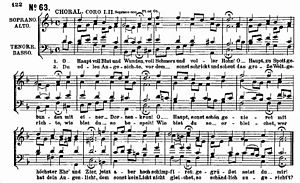
"O Haupt voll Blut und Wunden": the four-part chorale setting as included in the St. Matthew Passion
 |
Chromatic Fantasia and Fugue BWV 903 performed by Kevin MacLeod
|

"Aria" of the Goldberg Variations, showing Bach's use of ornaments –  Audio
Audio
 |
Sonata No. 3 in G minor for viola da gamba and harpsichord BWV 1029 performed by John Michel
|
 |
Keyboard Concerto No. 1 in D minor, BWV 1052 performed by the Fulda Symphonic Orchestra conducted by Simon Schindler with Johannes Volker Schmidt (piano)
|
 |
Chaconne, 5th movement of Partita for Violin No. 2, BWV 1004
|

The Art of Fugue (title page) – Performed by Mehmet Okonsar on organ and harpsichord:  Nos. 1–12 •
Nos. 1–12 •  Nos. 13–20
Nos. 13–20
 |
Double Violin Concerto in D minor BWV 1043 performed by the Advent Chamber Orchestra with David Perry and Roxana Pavel Goldstein (violins)
A strictly contrapuntal composition (the two violins playing in canon throughout) in the guise of an Italian type of concerto
|
Analysis of the counterpoint of the chorale prelude Herr Jesu Christ, dich zu uns wend', BWV 632 (Orgelbüchlein)
the images of this video show the intertwining of melodies and motives, including the melody of the chorale "Herr Jesu Christ, dich zu uns wend'" (
|
Religious music was at the centre of Bach's output for much of his life. The hundreds of sacred works he created are usually seen as manifesting not just his craft but a truly devout relationship with God.[75][76] He had taught Luther's Small Catechism as the Thomaskantor in Leipzig, and some of his pieces represent it.[77] The Lutheran chorale was the basis of much of his work. In elaborating these hymns into his chorale preludes, he wrote more cogent and tightly integrated works than most, even when they were massive and lengthy.[citation needed] The large-scale structure of every major Bach sacred vocal work is evidence of subtle, elaborate planning to create a religiously and musically powerful expression. For example, the St Matthew Passion, like other works of its kind, illustrated the Passion with Bible text reflected in recitatives, arias, choruses, and chorales; but in crafting this work, Bach created an overall experience that has been found over the centuries since to be both musically thrilling and spiritually profound.[78]
Bach published or carefully compiled in manuscript many collections of pieces that explored the range of artistic and technical possibilities inherent in almost every genre of his time except opera. For example, the The Well-Tempered Clavier comprises two books, each of which presents a prelude and fugue in every major and minor key, displaying a dizzying variety of structural, contrapuntal and fugal techniques.[79]
Four-part harmony
Four-part harmonies predate Bach, but he lived during a time when modal music in Western tradition was largely supplanted in favour of the tonal system. In this system a piece of music progresses from one chord to the next according to certain rules, each chord being characterised by four notes. The principles of four-part harmony cannot only be found in Bach's four-part choral music, but he also prescribes it for instance for the figured bass accompaniment.[80] The new system was at the core of Bach's style, and his compositions are to a large extent considered as laying down the rules for the evolving scheme that would dominate musical expression in the next centuries. Some examples of this characteristic of Bach's style and its influence:- When in the 1740s Bach staged his arrangement of Pergolesi's Stabat Mater he upgraded the viola part (that in the original composition plays unisono with the bass part) to fill out the harmony, thus conforming the composition to his four-part harmony style.[81]
- When from the 19th century in Russia there was a discussion about the authenticity of four-part Court chant settings, compared to earlier Russian traditions, Bach's four-part Chorale settings, such as those ending his Chorale cantatas, were considered as the model of the foreign influence: such influence was however deemed unavoidable.[82]
Modulations
Modulations, changing key in the course of a piece, is another style characteristic where Bach goes beyond what was usual in his time. Baroque instruments vastly limited modulation possibilities: keyboard instruments, prior to a workable system of temperament, limited the keys that could be modulated to, and wind instruments, especially brass instruments such as trumpets and horns, about a century before they were fitted with valves, were tied to the key of their tuning. Bach pushed the limits: he added "strange tones" in his organ playing, confusing the singing, according to an indictment he had to face in Arnstadt,[83] and Louis Marchand, another early experimenter with modulation, seems to have avoided confrontation with Bach because the latter went further than anyone had done before.[84] In the "Suscepit Israel" of his 1723 Magnificat he had the trumpets in E-flat play a melody in the enharmonic scale of C minor.[85]The major development taking place in Bach's time, and to which he contributed in no small way, was the development of a temperament for keyboard instruments that allowed to use these in all available keys (12 major and 12 minor), and which allowed modulating without retuning. Already his Capriccio on the departure of a beloved brother, a very early work, showed a gusto for modulation incomparable to any contemporary work this composition has been compared to,[86] but the full expansion came with The Well-Tempered Clavier, using all keys, which Bach seems to have been developing from around 1720, with the Klavierbüchlein für Wilhelm Friedemann Bach as one of its earliest witnesses.[87]
Ornamentation
The second page of the Klavierbüchlein für Wilhelm Friedemann Bach is an ornament notation and performance guide that Bach wrote for his eldest son, who was nine years old at the time. Bach was generally quite specific on ornamentation in his compositions (where in his time much of the ornamentation was not written out by composers, rather being considered a liberty of the performer),[88] and his ornamentation was often quite elaborate. For instance, the "Aria" of the Goldberg Variations has rich ornamentation in nearly every measure. Bach's dealing with ornamentation can also be seen in a keyboard arrangement he made of Marcello's Oboe Concerto: he added written out ornamentation, which, some centuries later, is played by oboists when performing the concerto.Although Bach did not write any opera, he was not averse to the genre, nor to its ornamented vocal style. In church music, Italian composers had imitated the operatic vocal style in genres such as the Neapolitan mass. In Protestant surroundings there was more reticence to adopt such style for liturgical music. For instance Kuhnau, Bach's predecessor in Leipzig, had notoriously written against opera and Italianate virtuoso vocal music.[89] Bach was less imbued; one of the comments after a performance of his St Matthew Passion was that it all sounded much like opera.[90]
Giving soloist roles to continuo instruments
In concerted playing in Bach's time the basso continuo, consisting of instruments such as organ, and/or viola da gamba and harpsichord, usually had the role of accompaniment: providing the harmonic and rhythmic foundation of a piece. From the late 1720s Bach had the organ play concertante (i.e. as soloist) with the orchestra in instrumental cantata movements,[91] a decade before Handel published his first organ concertos.[92] Apart from the 5th Brandenburg Concerto and the Triple Concerto, which already had harpsichord soloists in the 1720s, Bach wrote and arranged his harpsichord concertos in the 1730s,[93] and in his sonatas for viola da gamba and harpsichord neither instrument plays a continuo part: they are treated as equal soloists, way beyond the figured bass role. In this sense Bach played a key role in the development of genres such as the keyboard concerto.[94]Instrumentation
Bach wrote virtuoso music for specific instruments, as well as music independent of instrumentation. For instance the Sonatas and partitas for solo violin are considered the pinnacle of what has been written for this instrument, only within reach of accomplished players: the music fits the instrument, pushing it to the full scale of its possibilities, requiring virtuosity of the player, but without bravura. Notwithstanding that the music and the instrument seem inseparable, Bach made transcriptions for other instruments of some pieces of this collection. Similarly for the cello suites, the virtuoso music seems tailored for the instrument, the best of what is on offer for it, yet Bach made an arrangement for lute of one of these suites. Likewise for much of his most virtuoso keyboard music. Bach exploited the capabilities of an instrument to the fullest, while keeping the core of such music independent of the instrument on which it is performed.In this sense it is no surprise that Bach's music is easily and often performed on instruments it was not necessarily written for, that it is transcribed so often, and that his melodies turn up in unexpected places such as jazz music. Apart from that, Bach left a number of compositions without specified instrumentation: the Canons BWV 1072–1078 fall in that category, as well as the bulk of The Musical Offering and The Art of Fugue.[95]
Counterpoint
Another characteristic of Bach's style is his extensive use of counterpoint (as opposed to the homophony used, for instance, in his four-part Chorale settings). Bach's Canons and, most of all, his Fugues are most characteristic of this style: also here Bach did not invent the style, but his contribution to it was so fundamental that he defined it to a large extent. Fugues are as characteristic to Bach's style, as, for instance, the Sonata form is characteristic to the composers of the Classical period.[96]Not only these strictly contrapuntal compositions, but most of Bach's music is characterised by distinct melodic lines for each of the voices, where the chords formed by the notes sounding at a given point follow the rules of four-part harmony. Forkel, Bach's first biographer, gives this description of this feature of Bach's music, that sets it apart from most other music:[97]
If the language of music is merely the utterance of a melodic line, a simple sequence of musical notes, it can justly be accused of poverty. The addition of a Bass puts it upon a harmonic foundation and clarifies it, but defines rather than gives it added richness. A melody so accompanied—even though all the notes are not those of the true Bass—or treated with simple embellishments in the upper parts, or with simple chords, used to be called “homophony.” But it is a very different thing when two melodies are so interwoven that they converse together like two persons upon a footing of pleasant equality. In the first case the accompaniment is subordinate, and serves merely to support the first or principal part. In the second case the two parts are not similarly related. New melodic combinations spring from their interweaving, out of which new forms of musical expression emerge. If more parts are interwoven in the same free and independent manner, the apparatus of language is correspondingly enlarged, and becomes practically inexhaustible if, in addition, varieties of form and rhythm are introduced. Hence harmony becomes no longer a mere accompaniment of melody, but rather a potent agency for augmenting the richness and expressiveness of musical conversation. To serve that end a simple accompaniment will not suffice. True harmony is the interweaving of several melodies, which emerge now in the upper, now in the middle, and now in the lower parts.
From about the year 1720, when he was thirty-five, until his death in 1750, Bach's harmony consists in this melodic interweaving of independent melodies, so perfect in their union that each part seems to constitute the true melody. Herein Bach excels all the composers in the world. At least, I have found no one to equal him in music known to me. Even in his four-part writing we can, not infrequently, leave out the upper and lower parts and still find the middle parts melodious and agreeable.
Structure, lyrics
Bach devoted more attention than his contemporaries to the structure of compositions. This can be seen in minor adjustments he made when adopting someone else's composition, for example his earliest version of the "Keiser" St Mark Passion, where he enhances scene transitions,[98] and in the architecture of his own compositions such as his Magnificat,[85] and his Leipzig Passions. In the last years of his life Bach would revise several of his prior compositions, often the recasting of such previously composed music in an enhanced structure being the most visible change, for example the Mass in B minor. Bach's known preoccupation with structure led, peaking around the 1970s, to various numerological analyses of his compositions, although many such over-interpretations were later rejected, especially when wandering off in symbolism-ridden hermeneutics.[99][100]The librettos, that is the lyrics, for his vocal compositions played an important role for Bach: he sought collaboration with various text authors for his cantatas and major vocal compositions, eventually writing or adapting such texts himself to make them fit in the structure of the composition he was designing, when he could not lean on the talents of other text authors. His collaboration with Picander for the St Matthew Passion libretto is best known, but there was a similar process to come to a multi-layered structure for his St John Passion libretto a few years earlier.[101]
Compositions
See also: List of compositions by Johann Sebastian Bach and List of fugal works by Johann Sebastian Bach

Bach's autograph of the recitative with the gospel text of Christ's death from St Matthew Passion. (Matthew 27:45–47a)
 |
Cantata Wachet auf, ruft uns die Stimme, BWV 140 performed by the MIT Concert Choir conducted by W. Cutter
|
 |
from Mass in B minor
|
 |
Prelude and Fugue in A minor, BWV 543 performed by Noah Horn on the 1974 Dirk A. Flentrop organ at the Oberlin Conservatory of Music
|
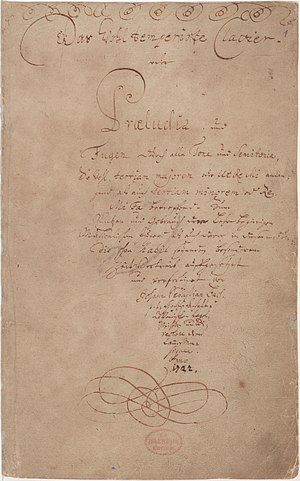
Title page of The Well-Tempered Clavier, book 1 –  Prelude No. 1 in C major BWV 846 performed on harpsichord by Robert Schröter
Prelude No. 1 in C major BWV 846 performed on harpsichord by Robert Schröter
 |
Italian Concerto BWV 971 performed by Martha Goldstein
|

Title page of the Goldberg Variations – performed by Mehmet Okonsar, piano:  Aria and Variation 1–9 •
Aria and Variation 1–9 •  Variation 10–22 •
Variation 10–22 •  Variation 23–30 and Aria da capo
Variation 23–30 and Aria da capo
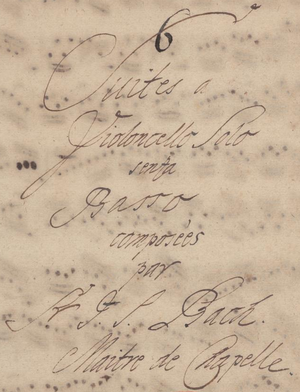
Title page of Anna Magdalena Bach's copy of the cello suites – Cello Suite No. 1 BWV 1007 performed by John Michel:  1. Prelude •
1. Prelude •  2. Allemande •
2. Allemande •  3. Courante •
3. Courante •  4. Sarabande •
4. Sarabande •  5. Minuets •
5. Minuets •  6. Gigue
6. Gigue
 |
|
 |
Some of Bach's most popular melodies are, more often than not, heard in various arrangements:
"Air", 2nd movement from Orchestral Suite No. 3 in D major, BWV 1068, performed in a Air on the G String adaptation by Capella Istropolitana conducted by Oliver von Dohnányi (courtesy of Naxos)
The Aria "Schafe können sicher weiden" (Sheep May Safely Graze), No. 9 from the Hunting Cantata, BWV 208: composed for soprano, recorders and continuo the music of this movement exists in a variety of instrumental arrangements.
|
| BWV Range | Compositions |
|---|---|
| BWV 1–224 | Cantatas |
| BWV 225–231 | Motets |
| BWV 232–243 | Liturgical compositions in Latin |
| BWV 244–249 | Passions and Oratorios |
| BWV 250–438 | Four-part chorales |
| BWV 439–524 | Small vocal works |
| BWV 525–771 | Organ compositions |
| BWV 772–994 | Other keyboard works |
| BWV 995–1000 | Lute compositions |
| BWV 1001–1040 | Other chamber music |
| BWV 1041–1071 | Orchestral music |
| BWV 1072–1078 | Canons |
| BWV 1079–1080 | Late contrapuntal works |
Passions and oratorios
Bach composed Passions for Good Friday services and oratorios such as the Christmas Oratorio, which is a set of six cantatas for use in the liturgical season of Christmas.[107][108][109] Shorter oratorios are the Easter Oratorio and the Ascension Oratorio.St Matthew Passion
See also: St Matthew Passion
With its double choir and orchestra the St Matthew Passion is one of Bach's most extended works.St John Passion
See also: St John Passion




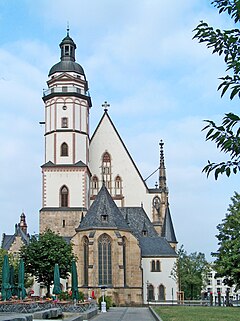

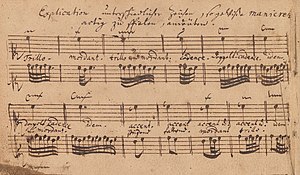


No comments:
Post a Comment